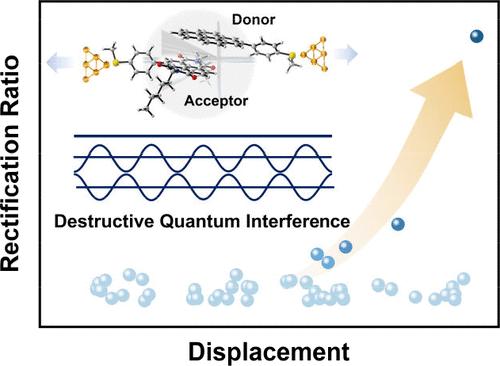Supramolecular Diodes with Donor–Acceptor Interactions
IF 15.6
1区 化学
Q1 CHEMISTRY, MULTIDISCIPLINARY
引用次数: 0
Abstract
Inspired by the initial proposal of σ-bridged donor–acceptor (D-σ-A) single-molecule diodes in 1974, extensive studies over the past 50 years have explored various designs for π-conjugated D-π–A single-molecule diodes due to their feasible chemical synthesis and effective charge transfer. However, the rectification ratio of π-conjugated single-molecule diodes has been long-term limited by the challenge of asymmetric electronic coupling to induce the rectification effect. Here, we present a supramolecular diode constructed through an intramolecular π–π interaction-driven assembly strategy. The asymmetric transmission in this system is tunable via subangström mechanical control, resulting in a rectification ratio of up to 16. Electron transport studies reveal that this through-space D-π–π–A system constructed by the π–π stacking between pyrene (Py) and naphthalenediimide (NDI) is crucial for achieving asymmetric currents under different bias polarization. Theoretical calculations suggest that the intermolecular destructive quantum interference not only enables a sharp variation in electron transmission but also facilitates asymmetric electronic energy shifts through mechanical stretching, significantly improving the rectification ratio. Our work provides a general approach to fabricating and modulating asymmetric molecular architectures through noncovalent supramolecular interactions, showcasing the potential of high-performance single-molecule rectifiers.

具有供体-受体相互作用的超分子二极管
自1974年首次提出σ-桥接给受体(D-σ-A)单分子二极管以来,由于π共轭D -π-A单分子二极管具有可行的化学合成和有效的电荷转移特性,在过去的50年里,人们对π共轭D -π-A单分子二极管进行了广泛的研究。然而,π共轭单分子二极管的整流率一直受到不对称电子耦合诱导整流效应的挑战。在这里,我们提出了一个通过分子内π -π相互作用驱动组装策略构建的超分子二极管。该系统中的非对称传动可通过subangström机械控制进行调节,导致整流比高达16。电子输运研究表明,由芘(Py)和萘二酰亚胺(NDI)之间的π -π堆叠构建的这种穿过空间的D-π -π - a体系是在不同偏置极化下实现不对称电流的关键。理论计算表明,分子间破坏性量子干涉不仅使电子传输发生剧烈变化,而且通过机械拉伸促进了电子能量的不对称转移,显著提高了整流比。我们的工作提供了一种通过非共价超分子相互作用来制造和调节不对称分子结构的通用方法,展示了高性能单分子整流器的潜力。
本文章由计算机程序翻译,如有差异,请以英文原文为准。
求助全文
约1分钟内获得全文
求助全文
来源期刊
CiteScore
24.40
自引率
6.00%
发文量
2398
审稿时长
1.6 months
期刊介绍:
The flagship journal of the American Chemical Society, known as the Journal of the American Chemical Society (JACS), has been a prestigious publication since its establishment in 1879. It holds a preeminent position in the field of chemistry and related interdisciplinary sciences. JACS is committed to disseminating cutting-edge research papers, covering a wide range of topics, and encompasses approximately 19,000 pages of Articles, Communications, and Perspectives annually. With a weekly publication frequency, JACS plays a vital role in advancing the field of chemistry by providing essential research.

 求助内容:
求助内容: 应助结果提醒方式:
应助结果提醒方式:


